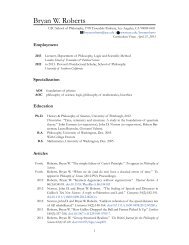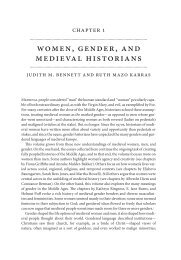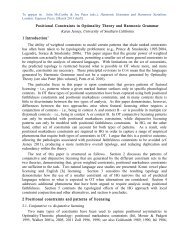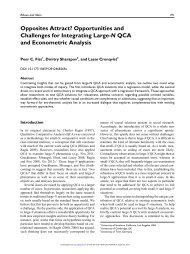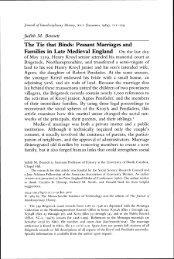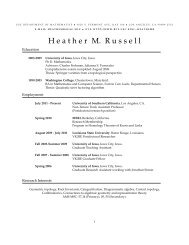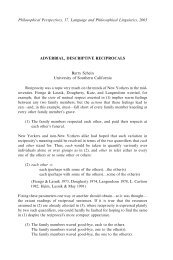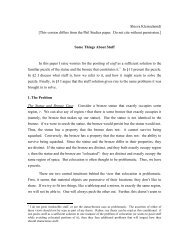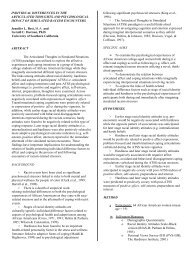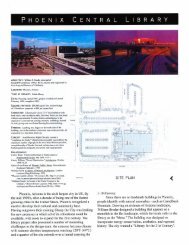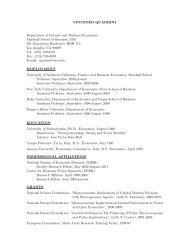The Racial Resegregation of Los Angeles County, 1940-2000
The Racial Resegregation of Los Angeles County, 1940-2000
The Racial Resegregation of Los Angeles County, 1940-2000
You also want an ePaper? Increase the reach of your titles
YUMPU automatically turns print PDFs into web optimized ePapers that Google loves.
3.0 Summary <strong>of</strong> Specific Findings:<br />
Great differences in the historical and recent dynamics <strong>of</strong> each <strong>of</strong> the major racial<br />
groups requires us to look at the question <strong>of</strong> “segregation” from each group’s<br />
perspective:<br />
WHITES<br />
• Whites became less isolated from all other racial groups, but only relatively so.<br />
Most <strong>of</strong> this “desegregation” is merely attributable to the simple decline in the<br />
number and proportion <strong>of</strong> Whites in the county (from 81% in 1960 to 32% in<br />
<strong>2000</strong>). Indeed, all four principal racial groups (Whites, Blacks, Hispanics, and<br />
Asians) were less likely to have White neighbors.<br />
• While the Index <strong>of</strong> Diversity has steadily increased for the entire <strong>Los</strong> <strong>Angeles</strong><br />
<strong>County</strong>, the Index <strong>of</strong> Dissimilarity (the standard measure <strong>of</strong> segregation), has<br />
remained constant for Whites since 1970, at exactly 57.<br />
• If Whites have any neighbors <strong>of</strong> color, they are most likely in <strong>2000</strong> to be Hispanic<br />
(25% probability). Twenty-five percent is the greatest chance Whites have ever<br />
faced <strong>of</strong> having a nonwhite neighbor. Whites had very little likelihood <strong>of</strong> having<br />
a Black or Asian neighbor through 1970 (no greater than 2%), but this likelihood<br />
increased only slightly by <strong>2000</strong>. Whites have a 14% probability <strong>of</strong> having an<br />
Asian neighbor; they still have only a 5% probability <strong>of</strong> having a Black neighbor.<br />
• Thus, from a White perspective, sharing neighborhoods with persons <strong>of</strong> color has<br />
only advanced for the two groups whose population explosion since 1960 has<br />
virtually forced this sharing.<br />
• As a rule, Whites have resegregated themselves as the county as a whole has<br />
become hugely diverse. Simply by being outnumbered, the White population<br />
only seems less spatially exclusive on the face <strong>of</strong> certain indices. Examination <strong>of</strong><br />
maps shows that the White population has retreated to the suburban fringe <strong>of</strong> the<br />
metropolis, barricaded now behind the highest property values.<br />
BLACKS<br />
• Blacks have seen a very different transformation than Whites. <strong>The</strong> probability<br />
that blacks would have White neighbors actually fell steeply from <strong>1940</strong> through<br />
1970, from 45% to 15%, and has stayed virtually constant ever since (hovering<br />
between 17% and 18%. Blacks have far fewer White neighbors than they did two<br />
generations ago, and no progress has been made since the nadir <strong>of</strong> the “urban<br />
crisis” in 1970. Blacks have a slightly greater chance <strong>of</strong> having Asian neighbors<br />
since 1970, but this figure is still only 9% in <strong>2000</strong>. Most striking is that Blacks<br />
are far more likely to have Hispanic neighbors. This probability shot up from<br />
11% in 1970 to 41% in <strong>2000</strong>. Like Whites, Blacks have been less and less likely<br />
Race Contours <strong>2000</strong> –<strong>Resegregation</strong> <strong>of</strong> <strong>Los</strong> <strong>Angeles</strong> <strong>County</strong>, <strong>1940</strong>-<strong>2000</strong> 8



